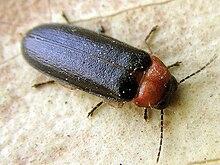Luciolinae
| Luciolinae | |
|---|---|

| |
| Luciola lusitanica male | |
| Scientific classification | |
| Domain: | Eukaryota |
| Kingdom: | Animalia |
| Phylum: | Arthropoda |
| Class: | Insecta |
| Order: | Coleoptera |
| Family: | Lampyridae |
| Subfamily: | Luciolinae Lacordaire, 1857 |
| Genera | |
|
Several, including: | |
The Luciolinae are among the largest subfamilies of fireflies (Lampyridae). They seem to be all "flashing" (as opposed to "continuous-glow") fireflies. They are a diverse lineage, spreading throughout the warm parts of Eurasia into temperate Europe and East Asia and south to the Australian region.[1]
Several tropical species, notably of the genus Pteroptyx, are of local economic importance. Their displays will self-synchronize until the entire local firefly population flashes in the same rhythm, creating a stunning spectacle that is popular with tourists. The most well-known location to witness these displays is on the Selangor River at Kampong Kuantan, Malaysia.
Two Japanese species of Luciola, collectively known as hotaru (蛍), are highly significant in Japanese culture and folklore. They are symbols of the hitodama (人魂 or 人玉), the souls of the newly dead. See also the explanations at the article on the movie Hotaru no Haka ("Grave of the Fireflies") for a discussion of the cultural significance of the hotaru.
Systematics
This subfamily is usually divided into two tribes, the monotypic Curtosini and the larger Luciolini. Occasionally, the Ototretinae are contained in this subfamily as a third tribe Ototetrini. The genus Pristolycus, usually placed in the Lampyrinae, appears to belong in this subfamily instead and represents a quite basal lineage.[1][2][3]
While Curtos certainly stands apart from the other genera, its precise relationships are far less resolvable than the placement as a distinct tribe presumes; it appears to share more autapomorphies with Atyphella and especially Pygoluciola – both were for some time included in Luciola – than with other genera, but whether this means an evolutionarily closer relationship (rendering the Curtosini invalid) remains to be tested.[2]
Photuroluciola, usually included in Luciola, might also warrant recognition as a distinct genus.[3]
From phylogenetic analyses of morphology, three possible clades (which could be considered tribes) can be inferred:[3][1]
- A basal group containing Bourgeoisia, Lampyroidea, and the "typical" Luciola which apparently includes Hotaria. Pristolycus and Curtos might belong here.
- A robustly supported and distinct group containing Colophotia, Pteroptyx, Pyrophanes, and Luciola species from Australia. They might be distinguished by larvae with soft terga that lack paranota, but this might alternatively be a plesiomorphic trait also present in other Luciolinae.[2]
- A weakly supported group of Atyphella (formerly in Luciola), Pygoluciola and possibly Curtos, which each seems very distinct but of unclear relationships with the other genera and groups.
References
- ^ a b c Stanger-Hall, Kathrin F.; Lloyd, James E. & Hillis, David M. (2007): Phylogeny of North American fireflies (Coleoptera: Lampyridae): Implications for the evolution of light signals. Molecular Phylogenetics and Evolution 45(1): 33-49. doi:10.1016/j.ympev.2007.05.013 PMID 17644427 (HTML abstract)
- ^ a b c Ballantyne, Lesley A. & Lambkin, C. (2006): A phylogenetic reassessment of the rare S. E. Asian firefly genus Pygoluciola Wittmer (Coleoptera: Lampyridae: Luciolinae). Raffles Bulletin of Zoology 53(1): 21-48. PDF fulltext
- ^ a b c Fu, Xin Hua & Ballantyne, Lesley A. (2008): Taxonomy and behaviour of lucioline fireflies (Coleoptera: Lampyridae: Luciolinae) with redefinition and new species of Pygoluciola Wittmer from mainland China and review of Luciola LaPorte. Zootaxa 1733: 1–44. PDF abstract
Further reading
- Ballantyne, Lesley A. & Menayah, Rasainthiran (2002): A description of larvae and redescription of adults of the firefly Pteroptyx valida Olivier in Selangor, Malaysia (Coleoptera: Lampyridae: Luciolinae), with notes of Luciolinae larvae. Raffles Bulletin of Zoology 50(1): 101-109. PDF fulltext
